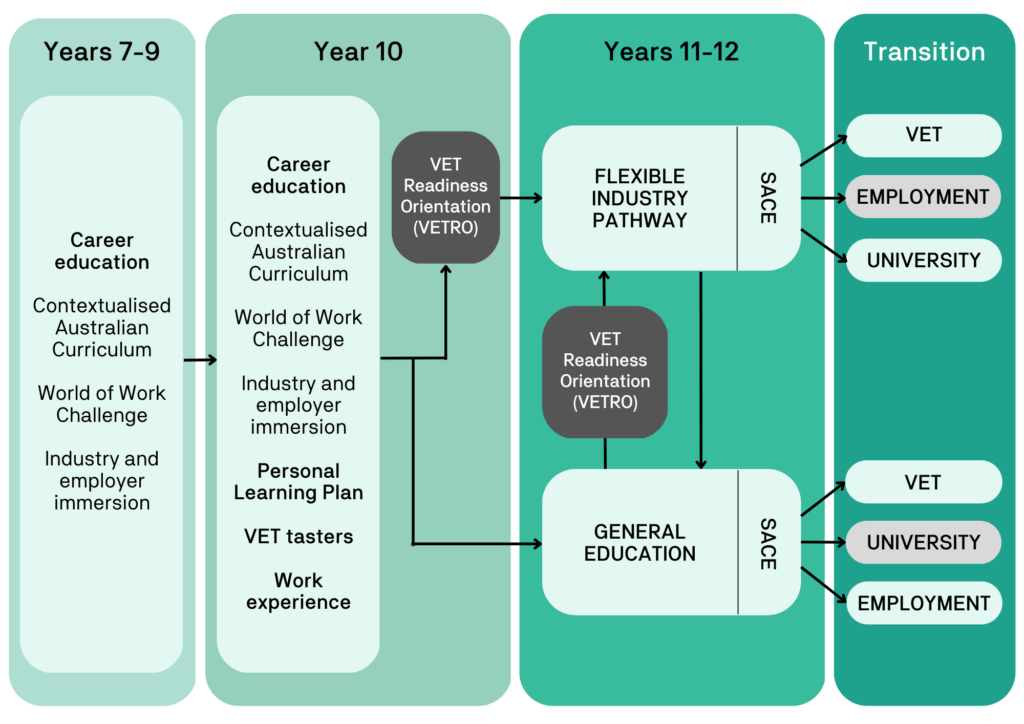Vocational Education & Training
What are flexible industry pathways?
Flexible industry pathways (FIPs) are a new way of approaching the delivery of vocational education and training (VET) in schools. FIPs are designed to prepare students for the world of work as well as meeting industry and employer needs. They support a student to enter the industry while completing their South Australian Certificate of Education (SACE).
Flexible industry pathway programs have been designed in consultation with industry and are aimed at equipping students with the skills, knowledge and qualifications to enter into employment or further study in the industry. FIPs provide students with a clearly articulated pathway through secondary school to employment, or further education in key growth industries across South Australia.
Students are supported to identify an appropriate flexible industry pathway suited to their interests and strengths through quality career education and industry immersion opportunities.
At ABHS, flexible industry pathways might take the form of:
- Accredited Training ‘VET’ Certificate Courses undertaken at a Certificate I, II or III level. Training is undertaken over 1-2 days each week and is accompanied by a complementary and adjusted school timetable. The accredited training provides SACE credits which balance the student’s completion pattern.
- School-Based Traineeships combining applicable accredited training with paid employment under a contract of training. This might look like one day per week accredited training plus one day paid work plus school subjects. Timetables are adjusted to support the FIP while maintaining a student’s SACE completion pattern.
- School Based Apprenticeships. Work-based training contracts combining paid work with accredited trade training. Students begin their apprenticeship while at school and continue full time at the completion of their schooling. A reduced school timetable, allowing 2-4 days at work per week with the remainder at school on a supportive class load, is most common. This is all outlined in a training plan that balances the needs of the employer, training, school and student.

Entry-level Certificate I, II and III courses via FIPs can be studied as part of Years 11 and 12 contributing to SACE and, in some cases, supporting tertiary entrance later if required. Flexible industry pathways via training can be entered at a number of sites including partnering schools and private training organisations.
ABHS hosts flexible industry pathways for the hospitality industry as part of the East Adelaide Secondary Vocational Alliance. These FIPs are delivered in the school’s industry standard Hospitality Training Centre.
VISIT EASVAFlexible industry pathway options
Students can gain access to a wide range of VET options off-campus delivered by training organisations including CEG, TAFE SA, MADEC, PEER and other private providers. Students must travel to the appropriate delivery sites to access their training.
The Department for Education has identified 26 flexible industry pathways in which they offer subsidies to students to complete qualifications in areas considered to be strategically important to the economy in terms of job growth and skills shortages.
Explore FIP optionsFIPs available in 2023
The FIPs available for delivery to students in 2023 include:
- Aged care and disability
- Animal care
- Agriculture
- Aquaculture
- Automotive retail, servicing and repair
- Building and construction
- Business start-up (entrepreneurial)
- Civil construction, resources and infrastructure
- Conservation and land management
- Cyber
- Early childhood
- Education
- Electrotechnology
- Food processing
- Forestry
- Hair and beauty
- Health support
- Horticulture
- Hospitality and tourism
- Information technology
- Manufacturing and engineering
- Maritime
- Plumbing
- Resources and infrastructure
- Thoroughbred racing
- Screen and media production, game development and visual effects
VET in a secondary education context

Embarking on VET
Vocational Education and Training Readiness Orientation (VETRO)
The VET Readiness Orientation (VETRO) has been developed by the Department for Education and Department for Innovation and Skills as the entry point to VET for school students. VETRO is an upfront assessment, induction, and orientation to ensure that students enrol in a VET course that is right for them and has their personal and learning support needs planned for.
VETRO determines a student’s readiness to commence a VET pathway and identifies any support that a student may need to commence vocational training. VETRO is usually carried out from Year 10 onwards if a student has decided to commence a flexible industry pathway.
As part of their VETRO application students must outline their previous relevant experience and decision making. This can take the form of relevant curriculum work, extra curricular involvement, work experience, Exploring Identities and Futures (EIF), and Career Action Plans outlining investigation towards the industry, ideally for skilled trades. This will be followed up by the training provider with an assessment of literacy and numeracy capability.
School-based apprenticeships and/or traineeships (SBATs)
As shown, SBAT’s can form Flexible Industry Pathways for school students. From the age of 15, students may, if they wish, enter a part-time, school-based apprenticeship or traineeship while still at school. This allows them to complete the SACE while, at the same time, commencing an apprenticeship or traineeship and then, on completion of Stage 2, transition straight to work. The minimum work requirement for these ASBAs is one day/7.5hours a week but, in Year 12, if students have completed all the compulsory aspects of SACE, they can participate in a Flexible Apprenticeship/Traineeship and more workdays can be negotiated per week.
> Learn more about School-based apprenticeships and traineeships
VET and the SACE
VET competencies from SACE accredited qualifications can earn students SACE credits. Put simply, each competency or unit in a course has a number of nominal hours placed against it by the provider. For every 70 nominal hours, 10 SACE credits are awarded. As a general rule, a Certificate I or II course awards Stage 1 credits, while a Certificate III or higher course awards Stage 2 credits. There are exceptions to this, however; for example, the Certificate III Retail is not Stage 2, while the Certificate II in Automotive Servicing counts towards Stage 2.
VET and the ATAR
Completed Certificate III Courses (excluding the Certificate III in Retail) can contribute to a student’s university aggregate.
As a basic overview, the completed Certificate III is given an average of the score from the 70 other credits used towards the aggregate out of 90. Where this average would be lower than any other available studies, it is not used.
Students and families should refer to information available on the SATAC website regarding ATAR calculation when considering information relating to tertiary entry.
Students and families considering using a non-FIP Certificate III program to support an ATAR should familiarise themselves with the Non-FIP VET section below.
Non-FIP VET study
VET courses being pursued to support an ATAR rather than industry connection, which fall outside of a flexible industry pathway, are not arranged or supported by the school. Students will not have timetable adjustments supported based on current or prior enrolment in non-FIP training.
Common courses undertaken by students in these circumstances are Certificate III in Business or Certificate III in Fitness. The benefit of undertaking these courses for ATAR support is not clear for all students, and they are neither recommended nor discouraged. It is up to students and families to make a decision.
Those looking to pursue non-FIP VET study to support an ATAR might consider fast track options offered by numerous training providers. Students and families are advised to be mindful of the possible impact on a student’s school timetable or overall study load. The school can support with resulting if desired, however, the qualifications can be taken directly to the SACE board for processing.
Workplace Learning
Workplace learning supports students to gain exposure to the world of work, make career decisions and gain employability skills. Workplace learning is a broad term that covers work placement programs including structured workplace learning and work experience.
Work experience is where students take part in a short-term industry placement, giving them exposure to, and an awareness of, the world of work and potential career pathways. Workplace learning can be of any period desired by the student, with two to three days usually providing a good balance so as not to impact on-site learning.
Structured work placements are linked to the VET program which the student is undertaking and may be provided on the job, by a teacher or trainer in a school, or by another training organisation.
Students are free to engage in workplace learning from Year 10 onwards once they have completed the WorkPro WHS preparation course.
The workplace learning process, including how to complete WorkPro and the Workplace Learning Agreement form, can be found on the ABHS Careers website under Workplace Learning. This must be completed and signed by all parties and returned to the Senior Leader Futures Ready Student Pathways a week prior to commencing the workplace learning.
